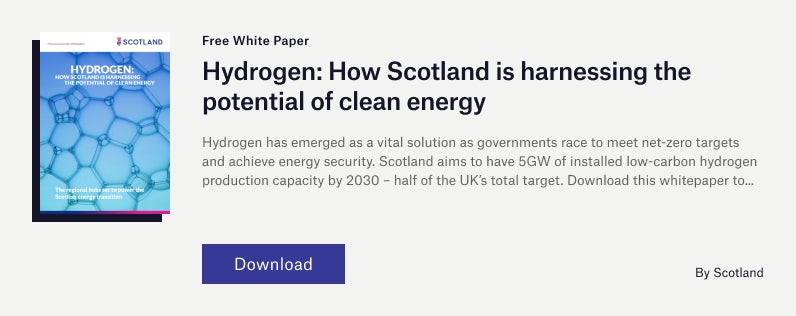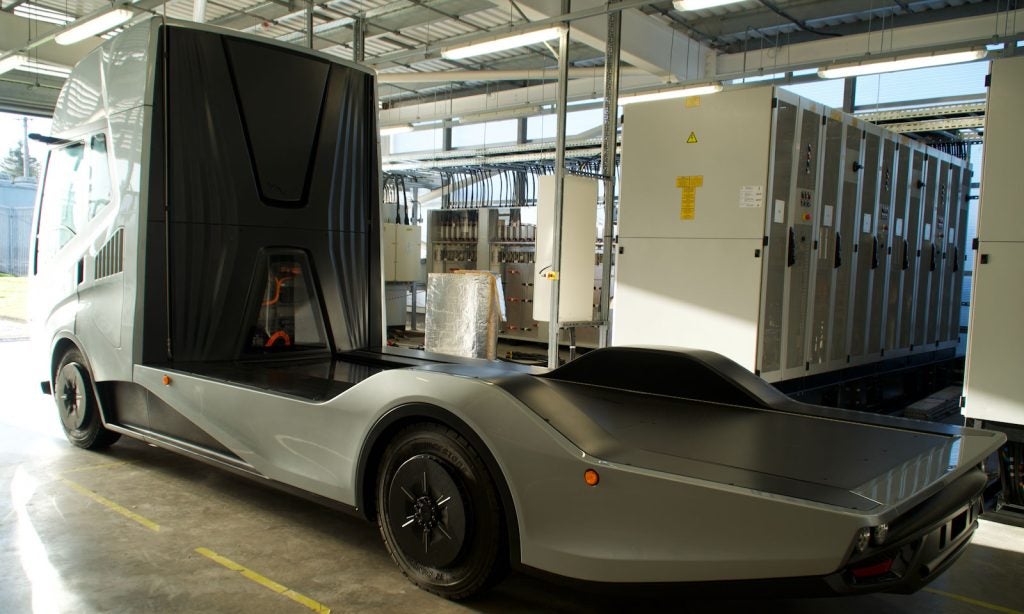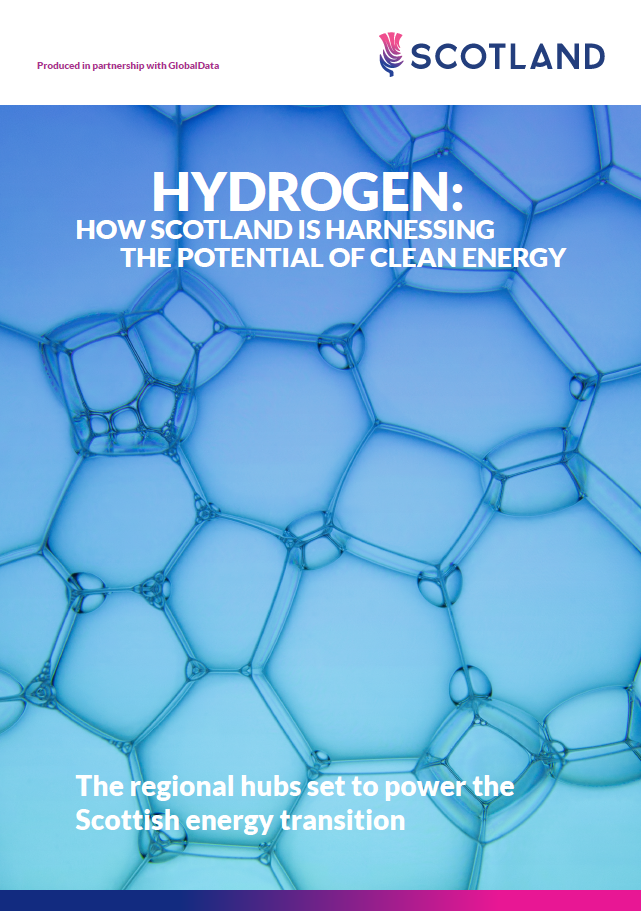
A key challenge facing the hydrogen economy is cost, but a new Scottish initiative encouraging innovation and cooperation could help to overcome this.
With the hydrogen sector still developing and determining the best path to scale-up, there are high early costs involved in production and ongoing uncertainty around near term market demand.

Even by 2030, the cost of hydrogen produced from renewables is projected to be $3.7/kg in the US and higher in the EU at $5.6/kg, according to figures from the International Council on Clean Transportation.
To enable hydrogen to compete with fossil fuels, prices must come down further – and a dramatic reduction may be possible as technology scales up and matures. Scotland could help to kick-start this much-needed shift by supporting the technology innovations required to make green hydrogen an economically viable alternative for a diverse range of industries.
Green hydrogen ambitions in Scotland
With global demand for hydrogen expected to rise significantly over the coming decades, Scotland is positioned to become a leading producer and exporter. By 2030, the country aims to have 5GW of installed capacity dedicated to the production of low-carbon hydrogen, increasing to 25GW by 2045.
This will be produced either by electrolysers powered by renewables to split water and create green hydrogen or by the regasification of natural gas with carbon capture to produce blue hydrogen. While blue hydrogen is needed in the short to medium term to build volumes for initial end users, green hydrogen is considered the more desirable long-term option and will make up the vast majority of production in Scotland.
A key initiative that could help to bring down the cost of green hydrogen production – and ultimately the market price – is Scotland’s Hydrogen Innovation Network, known as SHINe.
Launched in May 2024 by Scottish Enterprise, Scotland’s National Economic Development Agency, SHINe is a membership organisation created to support the existing hydrogen network and accelerate sector innovations through collaboration.
The core objective of SHINe is to act as a one-stop shop for hydrogen businesses, highlighting Scotland’s diverse sector capabilities in one place. The organisation works with investors to guide them through the layers of the Scottish funding landscape. This approach aims to attract key investment to Scotland’s growing hydrogen sector and establish the country as a global leader in hydrogen production.
In addition, SHINe works across the private and public sectors, offering companies of all sizes a platform where they can benefit from expert guidance, test centre infrastructure and networking opportunities. Acting as a bridge between newcomers and inward investment, the membership organisation is intended to reduce search and tender costs for growing businesses.
By providing resources and guidance on funding programmes, SHINe also seeks to decrease the risks and costs associated with new projects. In addition, the involvement of Scottish universities in the organisation provides access to funding and facilities that can help to further de-risk innovation projects.
Sharing capabilities and resources to further renewable hydrogen projects
Organisations already working through SHINe include the Net Zero Technology Centre, Powerhouse and Hydrogen Works.
One notable feature they are finding useful is SHINe’s capability directory, which lists existing hydrogen partners willing to provide support and facilitate integration into the Scottish industry. This tool provides companies and innovators with the means to identify potential collaborators for new projects.
“There is always an issue of never quite knowing what everyone’s doing and what opportunities or events are out there. Just to bring all that together under one initiative is great,” says Emma Swiergon, technology advisor at the Net Zero Technology Centre. “Looking through the capabilities of the other members, you get to know what other centres are doing.”
This increased visibility of projects may help to avoid the potential for two companies to spend time and money working on similar green hydrogen developments independently. Resources and knowledge can be shared more easily through SHINe, helping to reduce costs and potentially accelerate the project timeline.
“Everyone wants their own project moving forward, but there are areas where it is more efficient to work together,” adds Swiergon. “We have to collaborate to get where we need to be. It is pointless working in isolation. We need to learn from others and do this together, because it is ultimately about delivering Scotland’s ambition – it is not an individual’s goal.”

Collaborating to advance the hydrogen economy
Another member of SHINe is PNDC, one of the University of Strathclyde’s industry-facing innovation centres. PNDC specialises in research into whole energy systems, with facilities for testing and demonstration. The centre works alongside a range of partners to share expertise for accelerating and de-risking new systems for electricity, transport and heat – making the centre an ideal fit for the hydrogen economy. Crucially, PNDC helps to address some of the gaps in capabilities that may have been overlooked.
“We need more communication between the people who have already completed projects and identified some of the challenges,” says Dr Priya Bhagavathy, lead R&D engineer at PNDC.
“For hydrogen, key experts typically tend to look at chemical engineering or mechanical engineering, and may not consider some of the electrical aspects – until I go and talk to them about the challenges,” she adds. “So, it is good to have an opportunity to have people from different sectors or trades come into a single, coherent platform.”
Dr Bhagavathy highlights that in many instances, the technologies required already exist – they often just need adapting for the hydrogen economy.
“Some aspects have been used in other technologies for other industries and we don’t have to actually reinvent it,” she adds. “We can leverage what has already been done in other areas.”
Future innovations to reduce green hydrogen costs
The ambition is to make Scotland a net exporter of hydrogen by 2045, with innovation and collaboration integral to this. Supporting this ambition are the 13 Regional Hydrogen Hubs in development around Scotland that will focus on the complete life cycle, covering production, storage, distribution, end-use and export.
As one of Europe’s largest offshore renewable energy zones, Scotland has enormous potential to use this capacity to facilitate large-scale hydrogen projects. Crucially, the country’s existing oil and gas infrastructure and decades of technical expertise can be adapted for the hydrogen economy.
In Aberdeen, the Net Zero Technology Centre (NZTC) is working with SHINe to offer hydrogen start-ups places on the TechX Accelerator and Wind2Hydrogen programmes, which provide advice, guidance and opportunities in the hydrogen sector.
The NZTC is involved with many projects where collaborations lead to innovation and potential reductions in hydrogen costs. The organisation is running a competition that seeks designs for more efficient and cost-effective electrolysers.
On a much grander scale, another project could dramatically cut green hydrogen costs still further, particularly for export to markets of high demand. The NZTTP Hydrogen Backbone Link project could enable Scotland to meet up to 10% of Europe’s projected green hydrogen import demand by the mid-2030s via a pipeline. Transporting hydrogen in this way could see a substantial reduction in costs, with estimates suggesting that prices could eventually be as low as $0.40/kg when transporting gaseous hydrogen over 1,000km.
“Scotland has the capabilities to satisfy its own demands and also to export surplus green hydrogen. That Backbone Link being the connection point into Europe is going to be massive for us,” says Swiergon. “Ultimately, Scotland being a key producer of green hydrogen will help drive down the costs.”
The Backbone Link is a clear example of how collaborations lead to innovation and reduced costs for green hydrogen. Through SHINe, many more examples could soon follow.
To learn more about how the hydrogen economy is developing in Scotland, download the document below.
To learn more about SHINe, click here.



